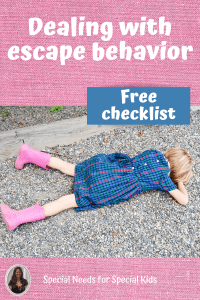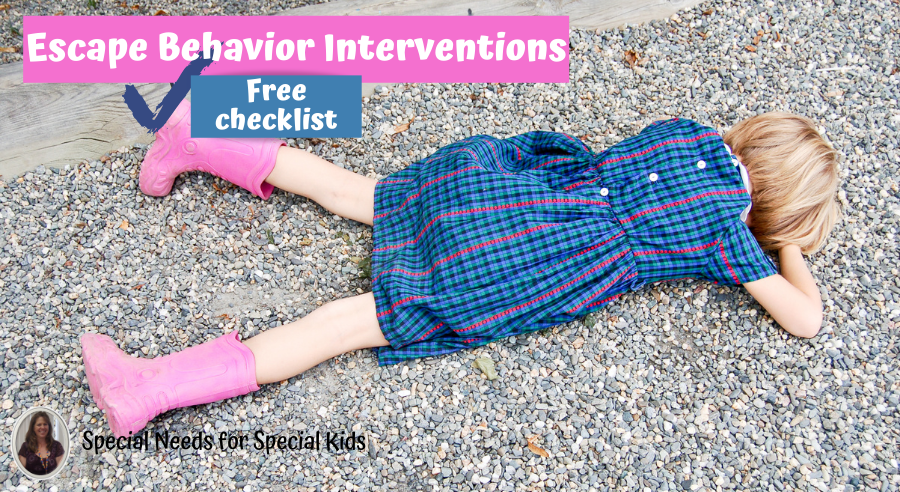Escape behavior is one of the most common behaviors we deal with in special education. There are four main functions of behavior:
- To escape a demand
- To get access to something tangible
- To get attention
- To get sensory input/self-stimulating
I thought it would be worthwhile to look at the first 3 functions more closely over the next few weeks. What does each one specifically look like? What clues can we look for? What are some appropriate and effective interventions?
You can download a detailed list of interventions for escape behaviors FREE by clicking HERE. No email required ?
What does escape behavior look like?
I think most of us can picture this situation in our classrooms or homes. We deal with students trying to get out work or a demand often. It can take the form of a full-out temper tantrum with kicking and screaming.
Or, it can be a student simply falling to the floor and refusing to move (my son’s favorite).
Or, it can be a student simply falling to the floor and refusing to move (my son’s favorite). Sadly, it can even be direct acts of physical or verbal aggression towards you, your staff, or another student. Finally, it can even be a very quiet refusal and avoidance of completing the work. In fact, sometimes it can be so quiet and subtle you may not even notice it as an escape behavior.
Depending on the makeup of your classroom, this behavior can look very different, but the desired result is always the same: to NOT do what you are asking them to do. And, unless you are getting these students at a very young age, these behaviors are often entrenched with years of reinforcement. Students will tweak and perfect their escape strategy to one that works on a consistent basis. This long reinforcement history can make them very difficult to redirect and shape into a new behavior.
What clues can we look for?
How do we know if the function of a student’s behavior is escape rather than something else? You probably won’t be able to figure this out on the very first try. It takes some detective work, trial and error, and watching how the student reacts to interventions you put in place. But, in general there are some common clues we can look for.
First, does the behavior occur immediately after you place a demand? Was the student engaging in appropriate behavior just before you made your request? If you then change the demand does the behavior stop? For example, if you ask a student to get out a paper and pencil to complete an assignment falls to the floor and crawls under the table. That may be an example of an escape behavior.
If you then ask that student who is still under the table if he would rather complete the assignment on the computer, and he jumps up, then that is even more evidence of escape behavior.
Second, escape behavior is often closely associated with and confused with wanting access to tangible things. For instance, in that same example above, if the student was playing with a fidget toy that you removed just before asking him to get out a paper and pencil and THEN the behavior occurs, it can be a little less clear. Is the behavior an attempt to regain access to the fidget or is it an attempt to escape the demand of having to write something? One easy way to tell is by allowing continued access to the fidget toy. Does the behavior still occur? Then the function is escape.
I know what you are thinking, isn’t the fidget toy itself a way to escape the demand? It can be. But, if the student was already using it before you placed the demand, then it is less likely the student is using the fidget toy to escape the demand. If you ask him to get out a paper and pencil, and then picks up a fidget toy instead, then, yes, he is likely using the fidget toy to escape the demand.
What are some interventions we can use?
I have a reference list to some of the interventions I talk about here as well as more options for dealing with escape type behaviors. Be sure to grab that and print it out for future reference. CLICK HERE
When I think about escape behaviors in the classroom, I think of 3 main ways to attack it and reshape and redirect this unwanted behavior.
1. Change the learning level of what I am teaching
2. Change the presentation of the material
3. Change the content of the material
1. Changing the learning level
Often times when a student is attempting to escape or get out of doing work, it is often because he/she expects that it will be too hard, or it will be too easy. If it is too difficult, the student may know he/she will feel frustrated and will be delayed access to something more desirable until the work is complete. It may feel overwhelming and exhausting to him/her. Having some good assessments and past information concerning difficulties a student may have is an excellent clue as to where the appropriate learning level should be. And, just to make it more complicated, our students often do not have the ability to understand or communicate that a task is too difficult or overwhelming. They cannot simply say, “I don’t know how.” or “That’s too hard.” We have to be able to “read” that in their actions and help them comprehend what those feelings really mean. Luckily, as teachers, we have lots of ways to test where a student is performing and then, just slightly, raising those expectations.
The other issue with learning level is that it can be too easy. This leads to students who are bored or feel like if they have to do this matching task one more time, they will lose their mind. So, instead, a behavior erupts to get out of doing work that is easy enough, but just boring as all get out. Take a good look at what you are asking your students to do on a regular basis. Is there truly enough variety? I preach the importance of repetition, but it absolutely must have some variety build in. Perhaps this is an IEP goal teachers have been working on for the past 15 years. It happens, believe me, I know. So, despite the inability to master the objective, the student is so incredibly bored with the task, an escape behavior comes out. Think about your materials and your lessons, especially if there seems to be a lot of negative behaviors associated with them. Are they rigorous enough to be stimulating, but not so difficult that they feel overwhelming?
2. Change the presentation
We have so many more options in our classrooms today when it comes to providing information to our students. Many of us still like and use the cut and paste worksheets (my favorite), some have iPads for every student and can upload work there, and some even have Chrome books or laptops for every student to access. In addition, many classrooms have ways for students to interact and manipulate the material on a larger scale, like on a Smart Board or a Promethean board.
Another way to change the presentation is to simply change the “pencil” your student can use. Can you add interesting markers to the mix? Some are scented and some even have glitter. Can they write on post-it notes that they can then remove and reposition around the room or in their notebooks? Could they type or text the answer into an old phone? Basically, is there a different way for your student to communicate what he/she knows in a less traditional and more exciting way?
3. Change the content
I am in several special education Facebook groups. I like to hear what teachers are dealing with, their wins as well as their struggles. Just today, I was reading the best post about a teacher who could not, for the life of her, get her students to complete a writing assignment. They refused; they were belligerent; they were abusive. Basically, they were displaying classic signs of escape behavior, and they were in high school, so they had plenty of years to perfect how to get out of doing a writing assignment. This teacher went on to share that after zero success for a semester, she changed it up and showed them some videos on the Titanic. Although this was not directly covered in the curriculum, it sparked the interests of her students to the extent that every single one of them completed the writing assignment. Did she risk going “off script” with her administration? That I could not tell you, but she seemed way too happy in the post for that to be the case.
So many of our students have unique interests that, many of whom, are happy to perseverate on for hours. Is there a way to use that to our advantage? If you have a subject or activity that is frequently met with escape behaviors, could we change up the content that is more interesting to the student? Keep a running list of the interests your students have. When it comes to working through more challenging (or boring) activities, is there a way to pull in some of those interests? Just some simple planning ahead of time can truly make all the difference.
I could go on for hours about escape behaviors and how to identify them as well as interventions to try. I could also talk a lot about what “not to do” when it comes to escape behaviors. But, for now, once you are fairly certain you are dealing with a behavior whose main function is escape, ask yourself:
1. Can I change the learning level of the activity?
2. Can I change the way I am presenting the material? or Can I change the way the student is providing the answer?
3. Can I change the content of the activity and still address the same skills?
➡️And, remember to download your free checklist with lots of specific examples HERE.
Pin for later:










3 Comments
Comments are closed.